Fourth Year
Strong specialisation is possible in the fourth year, when you study eight modules from a choice of nearly 100. You must do a minimum number of modules (typically four) from the list associated with your chosen Engineering Area. Alternatively, if you do not wish to choose four modules from an Engineering Area, you may instead qualify in General Engineering. The range of modules available is similar to that in year three (though topics are, of course, studied at a more advanced level), but also includes additional modules in topics of cross-disciplinary interest such as Sustainable Development, Nuclear Energy, Engineering Mathematics and foreign languages and modules in relevant topics from other courses within the University.
As engineering is a constantly evolving subject, the modules offered may vary from year to year, changing even during the course of your degree, to keep abreast of recent advances in different disciplines.
A major project, which you choose from an extensive list or propose yourself, runs throughout the final year and can be expected to occupy about half your time. This may involve some "blue-skies" research or have direct industrial application; both types of project can, and often do, involve collaboration with industry and can lead to vacation work or offers of full-time employment.
Example Projects
- Design of Temporary Shelters for Refugees
- Long Span Bridges and Tall Buildings
- Wheelchair Design
- Design and Fabrication of a Micro-Motor
- Aerodynamics of Power Kites
- Developing Cheap Efficient Water Turbines for a Remote Hill Tribe in South West China
- Lower Limb Prosthesis for a Racing Cyclist
Design of Temporary Shelters for Refugees
(Structural Engineering Project, Rachel Battilana)
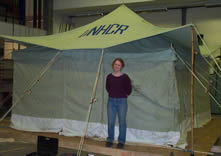 Emergency shelters currently used by the UN in cold weather situations are designed to have space-heating stoves inside them. Several hundred people froze to death in refugee tents in Afghanistan, when fuel supplies for their wood-burning stoves failed to materialise. Such shelters were also used in the Balkans in 1998, where temperatures during the winter months got down to –20°C, combined with Gale Force 6 winds, but the quantity of fuel required to bring the current design of tent up to even survival temperatures is colossal.
Emergency shelters currently used by the UN in cold weather situations are designed to have space-heating stoves inside them. Several hundred people froze to death in refugee tents in Afghanistan, when fuel supplies for their wood-burning stoves failed to materialise. Such shelters were also used in the Balkans in 1998, where temperatures during the winter months got down to –20°C, combined with Gale Force 6 winds, but the quantity of fuel required to bring the current design of tent up to even survival temperatures is colossal.
My project was to investigate the current tent design and come up with some recommendations to improve the situation. One of the main problems is that the tents are very draughty, so an obvious solution is to provide an internal liner. A materials company called Web Dynamics, who have worked on this project before, agreed to make some special, breathable, insulating fabric for a liner. The fabric was sewn up into a liner shape by H.M. Ashwell High Security Prison Textile Department: no mean feat as the material consists of 50 m2 of what essentially looks like a big white duvet.
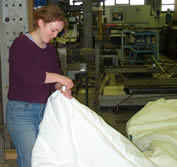 Initial testing of the tent with liner was carried out using a brand new environmental test chamber belonging to the Ford Motor Company in Essex. This is normally used to test the performance of vehicles and is capable of simulating Arctic temperatures and howling winds. For a long weekend in February it was home to our refugee shelter, as we tested it under wintry Kosovan conditions, using thermocouples to map out temperatures in and around the tent, and a thermal image camera to observe where the heat was escaping. An electric heater was set up inside the tent to model the effect of a wood-burning stove with the "UN recommended" heat output. Results were better than I had hoped, with temperatures soaring alarmingly towards 50°C when using the tent in conjunction with the liner.
Initial testing of the tent with liner was carried out using a brand new environmental test chamber belonging to the Ford Motor Company in Essex. This is normally used to test the performance of vehicles and is capable of simulating Arctic temperatures and howling winds. For a long weekend in February it was home to our refugee shelter, as we tested it under wintry Kosovan conditions, using thermocouples to map out temperatures in and around the tent, and a thermal image camera to observe where the heat was escaping. An electric heater was set up inside the tent to model the effect of a wood-burning stove with the "UN recommended" heat output. Results were better than I had hoped, with temperatures soaring alarmingly towards 50°C when using the tent in conjunction with the liner.
I have also conducted field trials in the grounds of my College where a number of volunteers agreed to spend a night in the tent so that I could log temperatures with the tent in use on a cold ground base. Apart from the issue of saving lives, the aim is also to calculate how many truckloads of fuel (or forests of trees) can be saved by use of the liner. If the extra insulation proves economically and logistically viable, the UN will be interested in discussing what has been done and generating some changes.
Designing Long Span Bridges and Tall Buildings
(Structural Engineering Project, Simon de Neumann)
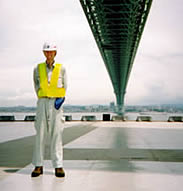 Anyone who has crossed a long-span suspension bridge, or stood at the top of a tall building, on a windy day will have experienced the effect of that wind in causing movement of the structure. The possibility of the catastrophic failure of a structure caused by wind effects has been known to design engineers since 1940, when the Tacoma Narrows bridge in the USA collapsed due to a phenomenon called flutter: the bridge was filmed undulating wildly before final collapse. Simon de Neumann decided to investigate this phenomenon for his fourth year project, based on structural engineering.
Anyone who has crossed a long-span suspension bridge, or stood at the top of a tall building, on a windy day will have experienced the effect of that wind in causing movement of the structure. The possibility of the catastrophic failure of a structure caused by wind effects has been known to design engineers since 1940, when the Tacoma Narrows bridge in the USA collapsed due to a phenomenon called flutter: the bridge was filmed undulating wildly before final collapse. Simon de Neumann decided to investigate this phenomenon for his fourth year project, based on structural engineering.
"Flutter is a phenomenon caused by the interaction of wind on a structure. Flutter is destructive. If you look out of an aircraft window and see the wings bouncing up and down: this is an aero-elastic interaction, as is flutter. Fortunately aircraft wings are designed to avoid flutter and to cope with this flapping effect without failing. It is important that structures are designed against aero-elastic effects too. Hopefully you will never see flutter develop in a building or a bridge – if you do, it might be the last thing you will see!
 At the moment, long span bridges and tall buildings are designed in a very conservative way, to allow for wind effects. A greater understanding of what is going on will allow more adventurous, yet safe, designs.
At the moment, long span bridges and tall buildings are designed in a very conservative way, to allow for wind effects. A greater understanding of what is going on will allow more adventurous, yet safe, designs.
I chose this project because it combined practical experimentation with theory and allows me to build up my knowledge in the subject of aero-elasticity, which is the field in which I want to work. For my project, I have built two models: one of a radically designed tall building, the 'Glasgow Wing Tower' which is 100m high and the other of a long span bridge which has been designed to span 3.3 km to cross the Messina Straits in Italy.
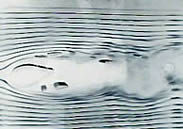 I had to get the design details of these structures from the engineering companies involved and having built the models, I have looked at how they react to different wind conditions using a wind tunnel. Smoke patterns, such as the one shown, allow me to visualise the effects, with the aid of which I can then thoroughly compare the practical results with the theory. Some of my results have been quite surprising, and I have been able to discuss them with the designers involved in the projects in industry.
I had to get the design details of these structures from the engineering companies involved and having built the models, I have looked at how they react to different wind conditions using a wind tunnel. Smoke patterns, such as the one shown, allow me to visualise the effects, with the aid of which I can then thoroughly compare the practical results with the theory. Some of my results have been quite surprising, and I have been able to discuss them with the designers involved in the projects in industry.
I would like, one day, to be involved in the design of a longer span bridge than any that have been built before. To do this I will need a good understanding of the principles of aero-elasticity."
Wheelchair Design
(Design & Manufacturing Engineering project, Lucy Porter)
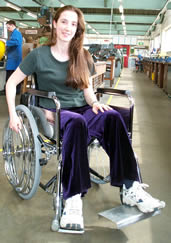 During a work placement at the end of her second year in Cambridge, Lucy Porter first came across the problems that wheelchairs pose for people who are hemiplegic (that is, paralysed down one side of their bodies).
During a work placement at the end of her second year in Cambridge, Lucy Porter first came across the problems that wheelchairs pose for people who are hemiplegic (that is, paralysed down one side of their bodies).
"If you can only use one side of your body, then all the control and propulsive inputs for the wheelchair have to be achieved from one side," she explains. "The standard issue NHS wheelchair for this purpose is so badly designed, that it is rarely used. The two hand rims are positioned beside the driving wheel on the active side of the body, and both can be turned by the active hand. To go in a straight line using this system you need to grip both hand rims simultaneously and rotate them at the same speed. However, as you can see from the picture, the rims are relatively widely spaced, which makes them difficult to grip with one hand, especially for people with small hands and little strength. Turning is even more difficult because you use the right-hand rim to turn the left wheel and vice versa. This is very counter-intuitive and difficult to get used to."
Lucy thought that making the standard NHS hemiplegic wheelchairs easier to use was an ideal project to tackle in her fourth year. Working closely with one of the Design Engineers in the Department, Mr Samuel Lesley, a brainstorming session led to a completely new concept which is the subject of patent applications. It allows straight-ahead forward or backward motion to be achieved using only one of the hand rims, and turning on the spot using only the other hand rim. While Mr Lesley designed the propulsion system, Lucy set about designing a foot-operated steering mechanism.
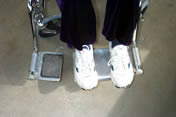
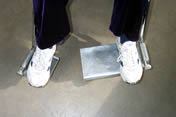
She came up with the idea of using a swivelling footplate on the person's active side, as shown. When not needing to actively steer, such as when travelling in a straight line on the flat or when being pushed by an attendant, the occupant of the wheelchair can relax with both feet on the wider fixed footplate. To steer, the active foot is placed on the swivelling footplate, which allows the front wheel to be steered. The steering disengages as soon as the foot is lifted off.
"By carrying out this design and manufacturing project, I learned how to use a commercial CAD program for 3D modeling (ProENGINEER) and I had to do the detailed design, right down to specifying which bearings and springs to use. Getting these practical details of design right is just as important as the conceptual design."
Hopefully, in the future, many stroke and brain-damaged patients will have cause to thank Lucy and the Department of Engineering for improving their mobility.
Design and Fabrication of a Magnetic Micro-Motor
(Electrical Engineering Project, Mark Grant)
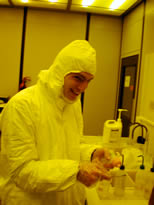 My project involves designing and building a very tiny motor, so small that it is only just visible to the naked eye. I am working with one other person, in a team of two, to fabricate the motor, which is based on the use of magnetic rather than electrostatic forces. Having come up with our design, we are now using the same methods of fabrication that people use to print circuits on silicon chips. That means that we start off by creating our design on a computer, and this is sent off and a mask fabricated which can then be used to expose a light sensitive material on a silicon wafer, so creating a 'photo' of our design on the surface.
My project involves designing and building a very tiny motor, so small that it is only just visible to the naked eye. I am working with one other person, in a team of two, to fabricate the motor, which is based on the use of magnetic rather than electrostatic forces. Having come up with our design, we are now using the same methods of fabrication that people use to print circuits on silicon chips. That means that we start off by creating our design on a computer, and this is sent off and a mask fabricated which can then be used to expose a light sensitive material on a silicon wafer, so creating a 'photo' of our design on the surface.
We now have to develop ways of etching away the material that has been exposed to the light to leave the tiny components that we need.
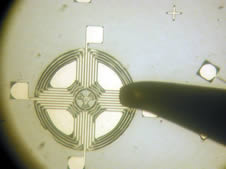 I chose this project because it crosses many disciplines, involving structures, mechanics, materials and manufacturing. We have had to learn all sorts of techniques of materials processing: how to evaporate thin films on the surface and how to etch these films to produce well defined components that do not get distorted during processing. All the work is carried out in a clean room. I hope that by the end of the project we will have produced a motor that will go round.
I chose this project because it crosses many disciplines, involving structures, mechanics, materials and manufacturing. We have had to learn all sorts of techniques of materials processing: how to evaporate thin films on the surface and how to etch these films to produce well defined components that do not get distorted during processing. All the work is carried out in a clean room. I hope that by the end of the project we will have produced a motor that will go round.
Applications for these types of motor that can be scaled up in size to be around 2–3 mm in diameter include pumping air or blood, generating electricity on a small scale, and powering other miniature devices.
Aerodynamics of Power Kites
(Aerodynamics project, Tristan Smith and Martin Kom)
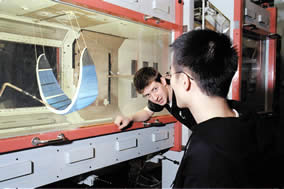 Flexifoil International Ltd. is one of the world's biggest manufacturers of performance kites. The company develop and manufacture specialist kites which are used in the rapidly growing sport of kite-surfing. These kites can be launched out of water and generate very large forces, sufficient to pull a person plus surfboard into the air for 'flight' times of up to 7 seconds. Similar kites are also used to achieve high speeds on water (outperforming windsurfers).
Flexifoil International Ltd. is one of the world's biggest manufacturers of performance kites. The company develop and manufacture specialist kites which are used in the rapidly growing sport of kite-surfing. These kites can be launched out of water and generate very large forces, sufficient to pull a person plus surfboard into the air for 'flight' times of up to 7 seconds. Similar kites are also used to achieve high speeds on water (outperforming windsurfers).
The pace of development has been so rapid that many of the fundamental aerodynamic problems of these kites are not understood, and it is this lack of understanding that hampers further progress. Two fourth year students, Tristan Smith and Martin Kom, have been working together on this project in co-operation with Flexifoil to experimentally investigate various aspects of kite aerodynamics. The aim of the project is to gather fundamental aerodynamic information which can be used in the development of future generations of performance kites.
Using a combination of wind tunnel testing, computational modelling and field trials, the students are using their knowledge of fluid mechanics to provide scientific information which can be used by the company's designers.
"It has been a great experience for us, as we not only get to test out the kites but have also learned a lot about how businesses operate by working with our industrial sponsors. It is a good way to apply the knowledge we have acquired during the course of our degree."
Developing Cheap Efficient Water Turbines for a Remote Hill Tribe in South West China
(Sustainable Development Design project, Alex Norman)
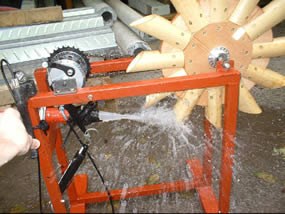 For my 4th-year project, I wanted something which would give me experience working with Non-Governmental Organisations (NGOs) in 3rd-world development, ideally including research in the field. Countless meetings and e-mails later, I spent the summer between my 3rd and 4th years in China.
For my 4th-year project, I wanted something which would give me experience working with Non-Governmental Organisations (NGOs) in 3rd-world development, ideally including research in the field. Countless meetings and e-mails later, I spent the summer between my 3rd and 4th years in China.
The project focussed on the Lisu people, a hill tribe in remote South-Western China. The aim was to give them an energy source for cooking to replace the use of fuel wood, which is leading to deforestation and serious erosion on the steep terrain.
I interviewed the Lisu villagers and evaluated their resources, before concluding that the main avenue for improvement lay in developing cheap but efficient water turbines that could be built and maintained in the hills. I designed, constructed and tested some sample turbines from bamboo and bicycle parts, as shown in the image.
They proved to be very efficient, and from this, I produced a blueprint for constructing turbines in Lisuland which Western agriculturalists working there are now using to produce a complete system which can be presented, demonstrated and taught to the Lisu tribe, with the intention that they then reproduce the systems themselves and teach others to do so.
It was as this second phase of work in China was getting under way that the project drew attention from the Royal Academy of Engineering Award for projects in 'sustainable development design', being nominated as the winner in Cambridge and coming second in the national poster competition held in London in July.
Development work can be very frustrating indeed; just finding the problem may involve overcoming huge cultural barriers and mutual misunderstandings, but it's incredibly interesting, educational and rewarding.
Lower Limb Prosthesis for a Racing Cyclist
(Biomedical Engineering, Tim Melville)
 The brief for my fourth year project was to design and build a replacement lower limb prosthesis for Keith Moore, a racing cyclist from near Cambridge. He suffered a cycling accident over 10 years ago and had to have his right leg amputated below the knee.
The brief for my fourth year project was to design and build a replacement lower limb prosthesis for Keith Moore, a racing cyclist from near Cambridge. He suffered a cycling accident over 10 years ago and had to have his right leg amputated below the knee.
Over the course of his rehabilitation, the NHS had provided him with a specialised cycling prosthesis. Although the fittings were bespoke, the design philosophy had been over-conservative, and there was a cumbersome arrangement of titanium tubing and heavy steel connectors. A considerable performance benefit could be achieved by making the new limb lighter and more streamlined.
Keith and his prosthetist were, however, satisfied with the geometry of his old prosthesis; the dimensions and angles between the stump socket and the pedal connection were to be preserved. What required engineering insight was the structural filling between the two ends.
A 4-ply isotropic lay-up of carbon-fibre-reinforced plastic was the material of choice, for its strength and stiffness-to-weight properties. I considered all possible loading scenarios for the structural member, to attain a design strength and stiffness. I consulted extensively with the prosthetic technicians at Addenbrooke's Hospital to guarantee the buildability of my design and that it could be funded by the NHS. I chose an aerofoil section for the main part of the member (whilst ensuring that my design would still be deemed legal for racing).
Construction took place in the Addenbrooke's workshops, with expert assistance from the technicians there. The old prosthesis was fitted into a jig which preserved the relative positions of the two ends. The socket was clad in a profiled template of stiff honeycomb foam, which provided the basis for laying up the woven carbon cloth. The epoxy resin was injected between polythene membranes either side of the carbon. After curing, the socket and foam were removed and the socket was glued back into place.
The new limb was over 600 g lighter than before, and Keith felt a noticeable improvement. I thoroughly enjoyed the challenge; it touched on many fields of engineering, from structural analysis to manufacturing. It gave me an opportunity to get hands-on, producing a tangible deliverable with an obvious benefit to the end-user.
